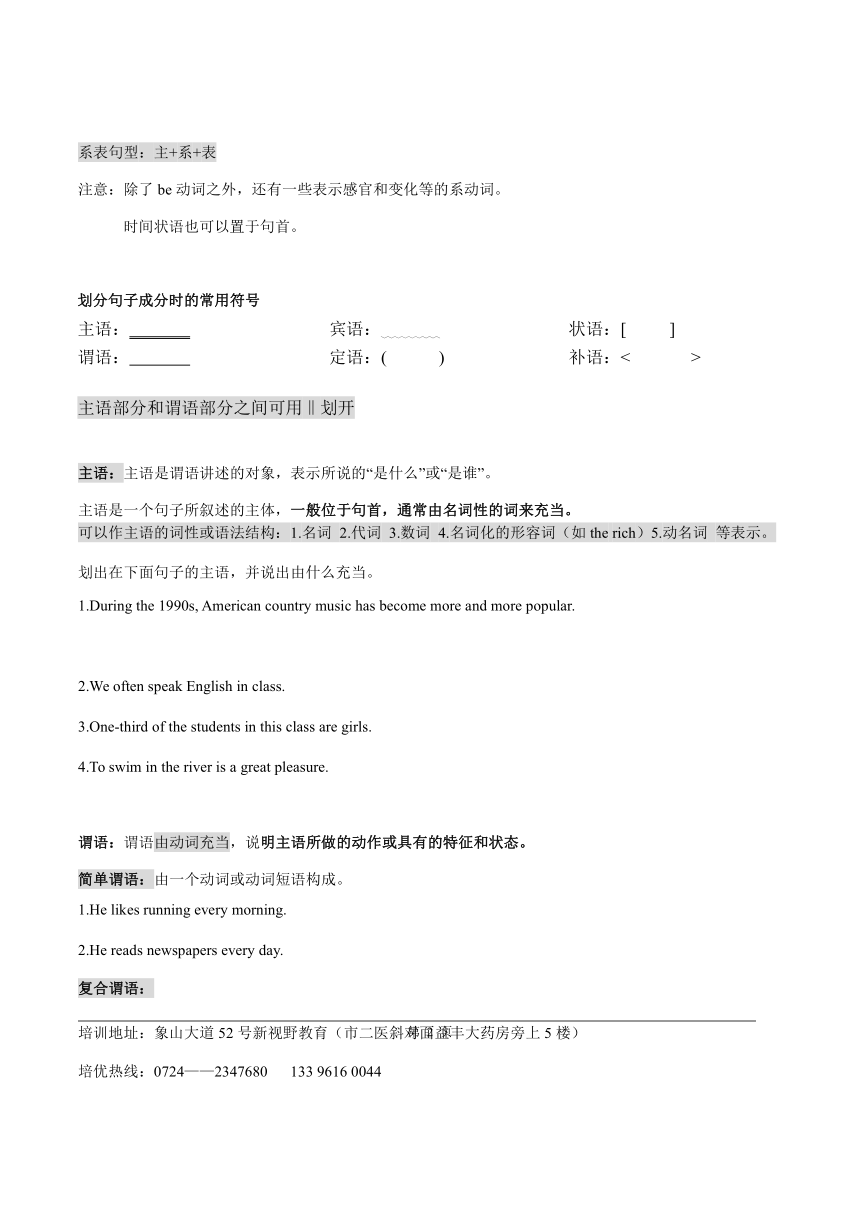2021年中考英语专题复习讲义-----第一讲 句子的构成和种类 (基础版)(含答案)
文档属性
| 名称 | 2021年中考英语专题复习讲义-----第一讲 句子的构成和种类 (基础版)(含答案) |  | |
| 格式 | docx | ||
| 文件大小 | 62.9KB | ||
| 资源类型 | 教案 | ||
| 版本资源 | 人教新目标(Go for it)版 | ||
| 科目 | 英语 | ||
| 更新时间 | 2021-03-10 18:04:41 | ||
图片预览





文档简介
目录
第一讲:句子的构成和种类 1
专题概述: 1
语法考点: 1
句子的种类 3
第二讲:名词 10
专题概述: 10
语法考点: 10
名词(Noun) 10
可数名词: 10
不可数名词: 12
名词所有格: 13
第三节:冠词 22
专题概述: 22
语法考点: 22
冠词(Article) 22
不定冠词a/an: 22
定冠词the的用法: 22
零冠词: 23
冠词的固定搭配: 23
第四讲:代词 30
专题概述: 30
语法考点: 30
代词(Pronoun) 30
人称代词和物主代词 30
反身代词 30
指示代词 31
不定代词 31
第五讲:介词 38
专题概述: 38
语法考点: 38
介词(preposition) 38
第六讲:形容词和副词 49
专题概述: 49
语法考点: 49
形容词(Adjective) 49
副词(Adverb) 49
形容词/副词原级的用法 50
形容词/副词比较级的用法 50
比较级的特殊用法 51
形容词/副词最高级的用法 51
第七讲:数词 57
专题概述: 57
语法考点: 57
第八讲:连词 64
专题概述: 64
语法考点: 64
连词(Conjunction) 64
第九讲:动词及时态 71
专题概述: 71
语法考点: 71
动词(Verb) 71
动词的分类 71
实义动词 71
连系动词 72
助动词 73
情态动词 73
动词短语 76
动词的时态 76
语法考点: 77
动词的甚本形式 78
第十讲:书面表达技巧 84
应用文写作 84
专题概述: 84
写作技巧提升: 84
书信 84
便条 84
通知 85
咨询建议文写作 86
专题概述: 86
第一讲:句子的构成和种类
专题概述:
英语的句子成分主要有六种:即主语、谓语、宾语、定语、状语和补语。(可以熟记为:主谓宾,定状补)除了这六种主要成分之外,还有“表语”和“同位语”的说法。但表语和系动词一起作谓语,因此划分成分时,划分在谓语上。同位语分为主语同位语和宾语同位语,属于主语或宾语的一部分。
六个成分即叙述的六要素:
①who(谁做,主语) ②action(做什么,谓语) ③who/which/what(被做了什么,宾语)
④how(状语,怎么做)⑤ where(状语,在哪里做)
⑥when(状语,何时做) 注意:时间状语可以置于句末,也可以置于句首。
语法考点:
128143044450 主谓句型——主语+谓语
主谓宾句型(一) ——主语+谓语+宾语
简单句五种基本句型 主谓宾句型(二) ——主语+谓语+间接宾语+直接宾语
主谓宾句型(三) ——主语+谓语+宾语+宾语补足语
主系表句型——主语+系动词+表语
无论句子的结构多么复杂,都不会超出简单句的五种基本框架。长句、难句都是这五种句型的扩充、套用和连用。影响句型结构的主要因素是谓语动词。
主谓句型:主语十谓语 主语+谓语+宾语
谓语动词是不及物的,其后可以接副词,说明动作发生的时间、地点、方式等。
具体顺序为:主/动/宾语或补足语/方式状语/地点状语/时间状语
主谓宾句型:双宾语和复合宾语(宾语+宾语补足语)
简单句的语序是主谓语先行,修饰语左右,动词的修饰状语一般在动词后,名词的修饰定语一般在名词的前面。
系表句型:主+系+表
注意:除了be动词之外,还有一些表示感官和变化等的系动词。
时间状语也可以置于句首。
划分句子成分时的常用符号
主语:
谓语:
宾语:
定语:( )
状语:[ ]
补语:< >
主语部分和谓语部分之间可用‖划开
主语:主语是谓语讲述的对象,表示所说的“是什么”或“是谁”。
主语是一个句子所叙述的主体,一般位于句首,通常由名词性的词来充当。
可以作主语的词性或语法结构:1.名词 2.代词 3.数词 4.名词化的形容词(如the rich)5.动名词 等表示。
划出在下面句子的主语,并说出由什么充当。
1.During the 1990s, American country music has become more and more popular.
2.We often speak English in class.
3.One-third of the students in this class are girls.
4.To swim in the river is a great pleasure.
谓语:谓语由动词充当,说明主语所做的动作或具有的特征和状态。
简单谓语:由一个动词或动词短语构成。
1.He likes running every morning.
2.He reads newspapers every day.
复合谓语:
① 由情态动词或其他助动词加动词构成。
1.You can keep the book for two weeks.
2.My sister is crying over there.
3.I would stay at home all day.
② 由系动词加表语构成。系动词不能单独作谓语,要和表语一起作谓语。
1.We are students.
2.Your idea sounds great.
3.He is a good boy.
表语:表语多是形容词,用以说明主语的身份、特征和状态,它一般位于系动词(如be, become, get, look, grow, turn, seem等)之后。表语一般由名词、代词、形容词、分词、数词、不定式、动名词、介词短语、副词及表语从句表示。
画出下列句中的表语,并说明由什么充当。
1.Our teacher of English is an American.
2.The weather has turned cold.
宾语:宾语由名词性的词充当,表示动作的对象或承受者,一般位于及物动词和介词后面。宾语分为动词宾语和介词宾语,分别构成动宾结构和介词结构。
画出下列句中的宾语, 并说明由什么充当。
1.They planted many trees yesterday.
2.They helped the old with their housework yesterday.
宾语补足语:英语中有些及物动词,除一个直接宾语以外,还要有一个宾语补语,才能使句子的意义完整。宾语补足语和宾语构成逻辑上的主谓关系。换句话说,在意思上,宾语相当于宾补的主语。
带有宾语补足语的一般句型为:某些及物动词(如make等)+宾语+宾补。宾补可由名词、形容词、副词、不定式、分词、介词短语和从句充当。
用下画线画出下列句中的宾语补足语,并指出是什么词充当,同时体会宾补和宾语之间的逻辑关系。
1.His father named him Dongming.
2.They painted their boat white.
3.Let the fresh air in.
主补:对主语的补充。含有宾语补足语的句子在变成被动语态,宾语作主语时,原来的宾补就成了主语补足语。
1.He was elected monitor.
2.She was found singing in the next room.
3.He was advised to teach the lazy boy a lesson.
定语:定语是对名词或代词起修饰、限定作用的词、短语或句子,汉语中常用“……的”表示。定语通常位于被修饰的成分前。许多情况下,定语是放在所修饰词后面的,这点与汉语习惯不同。
1.He didn't like the fat man.
2.The man next to me is a scientist.(我旁边的那个人)
单个形容词作定语一般放在所修饰词之前,而形容词短语作定语一般放在所修饰词之后。
1.The boy (under the tree) is Tom.(树下的那个男孩)
2.The tallest boy (in our class) is John.(我们班最高的那个男孩)
翻译下列句子,用下画线标出定语部分,留意定语的位置,并说明定语是由什么词性或结构充当。
1.The letter on the desk is for Mr. Wu.
2.The woman with a baby in her arms is his mother.
3.She carried a basket full of eggs.
状语:修饰动词、形容词、副词或整个句子, 说明动作或状态特征的句子成分,叫作状语。状语按意义分类可以表示时间、地点、原因、目的、结果、程度、条件、方式和让步等。
1.He writes carefully. He walks slowly. (认真地写,慢慢地走,修饰动词用副词,作状语)
2.This material is environmentally friendly. (修饰形容词用副词,作状语)
3.He runs very slowly. (修饰副词slowly, 因此very是副词,作状语)
4.Unfortunately, he lost all of his money. (修饰整个句子用副词,作状语)
注意频度副词的位置
频度副词often, always, usually, sometimes, never等在句中的位置位于情态动词、系动词、助动词之后, 实义动词之前。
1.You can never tell what he will do.
2.He is often late.
3.He is always helping others.
4.He often came late.
句子的种类
按使用目的,句子可分为陈述句、疑问句、祈使句和感叹句。
陈述句(Declarative Sentences):说明一个事实或陈述一种看法。例如:
1.Light travels faster than sound. 光比声传播速度快。(说明事实)
2.The film is rather boring. 这部电影很乏味。(说明看法)
疑问句(Interrogative Sentences):提出问题。有以下四种:
A.一般疑问句(General Questions):
Can you finish the work in time? 你能按时完成工作吗?
B.特殊疑问句(Wh-Questions):
Where do you live? 你住那儿?
C.选择疑问句(Alternative Questions):
Do you want tea or coffee? 你是要茶还是要咖啡?
D.反意疑问句(Tag-Questions):
He doesn't know her, does he? 他不认识她,对不对?
祈使句(Imperative Sentences):提出请求,建议或发出命令。例如:
Don't be nervous! 别紧张!
感叹句(Exclamatory Sentences):表示说话人惊奇、喜悦、愤怒等情绪。例如:
What good news it is! 多好的消息啊!
句子按其结构可以分为以下三类:
简单句(Simple Sentences):只包含一个主谓结构句子叫简单句。
She is fond of collecting stamps. 她喜欢集邮。
并列句(Compound Sentences):包含两个或两个以上主谓结构的句子叫并列句,句与句之间通常用并列连词或分号来连接。:
The food was good, but he had little appetite. 食物很精美,但他却没什么胃口。
复合句(Complex Sentences):包含一个主句和一个或几个从句的句子叫复合句,从句由从属连词引导。
The film had begun when we got to the cinema. 我们到达电影院的时候,电影已经开演了。
基本句型(Basic Sentence Patterns):英语中千变万化的句子归根结底都是由以下五种基本句型组合、扩展、变化而来的:
1. 主谓句型——主语+谓语
主谓宾句型(一)——主语+谓语+宾语
主谓宾句型(二)——主语+谓语+间接宾语+直接宾语
主谓宾句型(三)——主语+谓语+宾语+宾语补足语
主系表句型——主语+系动词+表语
第一讲课堂练习
句子成分练习
找出下面要求的句子成分。
1. 挑出下列句中的宾语
①?My brother?doesn't?do?his homework. ( )
A B C D
②?People?all?over?the world?speak?English. ( )
A B C D
2. 挑出下列句中的表语
①?The old man?is?very?tired. ( )
A B C D
② Why is?he?worried?about?Jim? ( )
A B C D
3. 挑出下列句中的定语
①?They?use?Mr. Mrs. with the?family?name. ( )
A B C D
②?What?is?your?given?name? ( )
A B C D
4. 挑出下列句中的宾语补足语
① She?likes?the children?to read newspapers and books?in the?reading-room. ( )
A B C D
② He?asks?her?to take the boy?out of school. ( )
A B C D
5. 挑出下列句中的状语
①?There?is?a big smile?on her face. ( )
A B C D
②?Every night?he?heard?the noise?upstairs. ( )
A B C D
6. 划出句中的直接宾语和间接宾语
① Please tell us a story.
② My father bought a new bike for me last week.
句型转换练习
1. I often help my parents. (改为一般疑问句)
________ you often ________ your parents?
2. They usually walk to school.(主语用she改写句子)
______ usually ______to school.
3. She often does her homework at home.(改为一般疑问句)
______ she often ______ her homework at home?
4. Yu Jing usually plays computer games after school. (同上)
_____ _____ Yu Jing usually ______ after school ?
5. They go to the library twice a week. (同上)
_____ _____ _____they go to the library?
6. He is looking for his soccer. (改为一般疑问句)
_____ _____ looking for his soccer?
7. I want to work in China because I love China and its people.(对画线部分提问)
______ ______you want to work in China?
8. It's Tuesday today. (对画线部分提问)
______ ______ is it today?
9. The class is over at eleven o'clock. (对画线部分提问)
______ ______ ______ the class over?
10. They have seven lessons every day. (对画线部分提问)
______ ______ lessons do they have every day?
11. There is a picture on the wall. (改为否定句)
______ ______ a picture on the wall.
12 . There is a boy in the room.(改为复数形式)
There _____ _____ _____ in the room.
13. Tom has some books. (改为一般疑问句)
_____ Tom _____ _____ books ?
14. The classroom is mine. (改为同义句)
This _____ _____ classroom .
15. There are seven days in a week. (对画线部分提问)
_____ _____ days are there in a week?
16. My shoes are under the bed. (对画线部分提问)
_____ _____ your shoes ?
17. There are some books and a pen in my desk. (改为一般疑问句)
_____ there _____books and a pen in my desk?
18. There are some computers in our school. (改为否定句)
There _____ _____ computers in our school.
19. My books are on the shelf. (对画线部分提问)
_____ _____ your books ?
20. Lan Lan is very glad to help others. (改为同义句)
Lan Lan _____ very _____ to help others.
21. There is an old man in the room. (改为复数形式)
There _____ _____ _____ _____ in the room.
22. There is some meat on the plate. (改为否定句)
There _____ _____ _____ on the plate.
23. There is a map of Beijing on the wall. (改为一般疑问句,并作肯定回答)
--____ ____ a map of Beijing on the wall .
--____, ____ ____.
24. There are thirteen trees behind the house. (对画线部分提问)
_____ _____ trees _____ _____ behind the house?
25. There are some books in the bookstore. (改为否定句)
There ______ ______ books in the bookstore.
26. There is an old building near my school. (改为复数形式)
There _____ _____ old _____ near my school.
27. Put them away, please. (改为否定句)
______ ______ them here, please.
28. She has four classes every morning. (改为否定句)
She _____ ______ four classes every morning .
29. They usually go to the library on foot. (改为同义句)
They usually _______ ________ the library .
30. My brother was born on the November 15th,1998. (对画线部分提问)
_____ ______ your brother born ?
31. I was born in Shanghai. (对画线部分提问)
_____ _____ you born ?
32. When is your birthday, Jim? (改为同义句)
When _____ you ______, Jim?
33. Today is Friday. (对画线部分提问)
______ ______ is it today?
第一讲课后练习
按要求划出句子中的成分
划出主语
We study in No. 17 middle school.
Jim is an American boy.
Two heads are better than one.
划出谓语
Time tries all thing.
Lucy is dancing under the tree.
Her parents are both workers.
划出宾语
Love me, love my dog.
These girls like English.
Did you see him yesterday?
划出表语
His father is a bus driver.
My car is white.
We were at school yesterday.
Health is wealth.
划出定语
The red one is mine.
What is his name?
A friend in need is a friend indeed.
划出状语
Our teacher works very hard.
She often helps Mike.
They had a meeting in Shanghai.
划出宾语补足语
We named the baby Lily.
She made the room clean.
1. Put them away, please. (改为否定句)
______ ______ them here, please.
2. She has four classes every morning. (改为否定句)
She _____ ______ four classes every morning .
3. There are two boats on the river. (对画线部分提问)
______ ______ boats are there on the river?
4. What about this picture? (改为同义句)
_______ _______ this picture ?
5. How many times a week do you play football? (改为同义句)
________ ________ do you play football ?
6. She looks at his new photos. (改为否定句)
She ______ ______ at his new photos .
7. My bedroom is next to my study. (对画线部分提问)
_______ _______ _______ bedroom ?
8. There are some apples on the table. (改为一般疑问句)
_______ _______ _______ apples on the table ?
9. Is there a yellow car near your house? (作否定回答)
_______, _______ _______ .
10. There are some children in the park. (改为否定句)
There _______ ________ children in the park .
11. My office is on the first street. (对画线部分提问)
________ ________ _______ office ?
12. There are some old men here. (改为单数形式)
_______ _______ ________ old man here .
13. Jim has an English class every day. (改为一般疑问句)
_______ Jim _______ an English class every day ?
14. I can sing English songs. (改为一般疑问句)
______ ______ sing English songs?
15. Can Li Lei play the guitar? (作否定回答)
No, ______ ______ .
16. Can you see the fish? (作否定回答)
_______ , I ________.
17. He buys his wife a nice dress. (改为同义句)
He _______ a nice dress______ his wife .
18. They like playing ball games. (改为一般疑问句)
_______ ______ like playing ball games ?
19. I like spring best. (对画线部分提问)
______ ______ do you like best ?
20. We can go swimming. (改为否定句)
We _____ _____ go swimming .
21. He usually returns home on Sunday. (改为同义句)
He usually ______ ______ home on Sunday .
22. What's your favorite season? (改为同义句)
______ season do you like _______ ?
23. They want to go to different countries. (改为同义句)
They ______ ______ ______ go to different countries .
24. I think he can play soccer. (改为否定句)
I _______ ________ he ________ play soccer .
25. His birthday is on October 2nd. (改为同义句)
He ________ ________ on October 2nd .
第一讲:句子的构成和种类
课堂练习
句子成分划分:1. DD 2.DB 3.CC 4. CC 5. DA
6. 划出句中的直接宾语和间接宾语
① Please tell us a story. ② My father bought a new bike for me last week.
间接 直接 直接 间接
句型转换:
1.Do;help 2.She;walk 3.Does;do 4.What does;do 5.How often do
6.Is he 7.Why do 8.What day 9.What time is 10.How many
11.There isn't 12.are some boys 13.Does;have any 14.is my
15.How many 16.Where are 17.Are;any 18.aren't any
19.Where are 20.Is;pleased 21.are some old men 22.isn't any meat
23.Is there;Yes,there is 24.How many;are there 25.aren't any 26.are some;buildings
27.Don't put 28.doesn't have 29.walk to 30.When was
31.Where were 32.were; born 33.What day
课后练习
句型转换
1.Don't put 2.doesn't have 3.How many 4.How about
5.How often 6.doesn't look 7.Where is your 8.Are there any
9.No,there isn't 10.Aren't any 11.Where is your 12.There is an
13.Does; have 14.Can you 15.he can't 16.No;can't
17.buys;for 18.Do they 19.Which season 20.can not
21.comes back 22.Which best 23.wish to go 24.don't think can 25.was born
-8890238125We were at school yesterday.
Health is wealth. (健康就是财富。)
定语
The red one is mine.
What is his name?
A friend in need is a friend indeed.(患难见真情。)
状语
Our teacher works very hard.
She often helps Mike.
They had a meeting in Shanghai.
宾语补足语
We named the baby Lily.
She made the room clean.
主语
We study in No. 17 middle school.
Jim is an American boy.
Two heads are better than one.
谓语
Time tries all thing.(时间检验一切)
Lucy is dancing under the tree.
Her parents are both workers.
宾语
Love me, love my dog. (爱屋及乌)
These girls like English.
Did you see him yesterday?
表语
His father is a bus driver.
My car is white.
We were at school yesterday.
Health is wealth. (健康就是财富。)
定语
The red one is mine.
What is his name?
A friend in need is a friend indeed.(患难见真情。)
状语
Our teacher works very hard.
She often helps Mike.
They had a meeting in Shanghai.
宾语补足语
We named the baby Lily.
She made the room clean.
主语
We study in No. 17 middle school.
Jim is an American boy.
Two heads are better than one.
谓语
Time tries all thing.(时间检验一切)
Lucy is dancing under the tree.
Her parents are both workers.
宾语
Love me, love my dog. (爱屋及乌)
These girls like English.
Did you see him yesterday?
表语
His father is a bus driver.
My car is white.
句子成分划
第一讲:句子的构成和种类 1
专题概述: 1
语法考点: 1
句子的种类 3
第二讲:名词 10
专题概述: 10
语法考点: 10
名词(Noun) 10
可数名词: 10
不可数名词: 12
名词所有格: 13
第三节:冠词 22
专题概述: 22
语法考点: 22
冠词(Article) 22
不定冠词a/an: 22
定冠词the的用法: 22
零冠词: 23
冠词的固定搭配: 23
第四讲:代词 30
专题概述: 30
语法考点: 30
代词(Pronoun) 30
人称代词和物主代词 30
反身代词 30
指示代词 31
不定代词 31
第五讲:介词 38
专题概述: 38
语法考点: 38
介词(preposition) 38
第六讲:形容词和副词 49
专题概述: 49
语法考点: 49
形容词(Adjective) 49
副词(Adverb) 49
形容词/副词原级的用法 50
形容词/副词比较级的用法 50
比较级的特殊用法 51
形容词/副词最高级的用法 51
第七讲:数词 57
专题概述: 57
语法考点: 57
第八讲:连词 64
专题概述: 64
语法考点: 64
连词(Conjunction) 64
第九讲:动词及时态 71
专题概述: 71
语法考点: 71
动词(Verb) 71
动词的分类 71
实义动词 71
连系动词 72
助动词 73
情态动词 73
动词短语 76
动词的时态 76
语法考点: 77
动词的甚本形式 78
第十讲:书面表达技巧 84
应用文写作 84
专题概述: 84
写作技巧提升: 84
书信 84
便条 84
通知 85
咨询建议文写作 86
专题概述: 86
第一讲:句子的构成和种类
专题概述:
英语的句子成分主要有六种:即主语、谓语、宾语、定语、状语和补语。(可以熟记为:主谓宾,定状补)除了这六种主要成分之外,还有“表语”和“同位语”的说法。但表语和系动词一起作谓语,因此划分成分时,划分在谓语上。同位语分为主语同位语和宾语同位语,属于主语或宾语的一部分。
六个成分即叙述的六要素:
①who(谁做,主语) ②action(做什么,谓语) ③who/which/what(被做了什么,宾语)
④how(状语,怎么做)⑤ where(状语,在哪里做)
⑥when(状语,何时做) 注意:时间状语可以置于句末,也可以置于句首。
语法考点:
128143044450 主谓句型——主语+谓语
主谓宾句型(一) ——主语+谓语+宾语
简单句五种基本句型 主谓宾句型(二) ——主语+谓语+间接宾语+直接宾语
主谓宾句型(三) ——主语+谓语+宾语+宾语补足语
主系表句型——主语+系动词+表语
无论句子的结构多么复杂,都不会超出简单句的五种基本框架。长句、难句都是这五种句型的扩充、套用和连用。影响句型结构的主要因素是谓语动词。
主谓句型:主语十谓语 主语+谓语+宾语
谓语动词是不及物的,其后可以接副词,说明动作发生的时间、地点、方式等。
具体顺序为:主/动/宾语或补足语/方式状语/地点状语/时间状语
主谓宾句型:双宾语和复合宾语(宾语+宾语补足语)
简单句的语序是主谓语先行,修饰语左右,动词的修饰状语一般在动词后,名词的修饰定语一般在名词的前面。
系表句型:主+系+表
注意:除了be动词之外,还有一些表示感官和变化等的系动词。
时间状语也可以置于句首。
划分句子成分时的常用符号
主语:
谓语:
宾语:
定语:( )
状语:[ ]
补语:< >
主语部分和谓语部分之间可用‖划开
主语:主语是谓语讲述的对象,表示所说的“是什么”或“是谁”。
主语是一个句子所叙述的主体,一般位于句首,通常由名词性的词来充当。
可以作主语的词性或语法结构:1.名词 2.代词 3.数词 4.名词化的形容词(如the rich)5.动名词 等表示。
划出在下面句子的主语,并说出由什么充当。
1.During the 1990s, American country music has become more and more popular.
2.We often speak English in class.
3.One-third of the students in this class are girls.
4.To swim in the river is a great pleasure.
谓语:谓语由动词充当,说明主语所做的动作或具有的特征和状态。
简单谓语:由一个动词或动词短语构成。
1.He likes running every morning.
2.He reads newspapers every day.
复合谓语:
① 由情态动词或其他助动词加动词构成。
1.You can keep the book for two weeks.
2.My sister is crying over there.
3.I would stay at home all day.
② 由系动词加表语构成。系动词不能单独作谓语,要和表语一起作谓语。
1.We are students.
2.Your idea sounds great.
3.He is a good boy.
表语:表语多是形容词,用以说明主语的身份、特征和状态,它一般位于系动词(如be, become, get, look, grow, turn, seem等)之后。表语一般由名词、代词、形容词、分词、数词、不定式、动名词、介词短语、副词及表语从句表示。
画出下列句中的表语,并说明由什么充当。
1.Our teacher of English is an American.
2.The weather has turned cold.
宾语:宾语由名词性的词充当,表示动作的对象或承受者,一般位于及物动词和介词后面。宾语分为动词宾语和介词宾语,分别构成动宾结构和介词结构。
画出下列句中的宾语, 并说明由什么充当。
1.They planted many trees yesterday.
2.They helped the old with their housework yesterday.
宾语补足语:英语中有些及物动词,除一个直接宾语以外,还要有一个宾语补语,才能使句子的意义完整。宾语补足语和宾语构成逻辑上的主谓关系。换句话说,在意思上,宾语相当于宾补的主语。
带有宾语补足语的一般句型为:某些及物动词(如make等)+宾语+宾补。宾补可由名词、形容词、副词、不定式、分词、介词短语和从句充当。
用下画线画出下列句中的宾语补足语,并指出是什么词充当,同时体会宾补和宾语之间的逻辑关系。
1.His father named him Dongming.
2.They painted their boat white.
3.Let the fresh air in.
主补:对主语的补充。含有宾语补足语的句子在变成被动语态,宾语作主语时,原来的宾补就成了主语补足语。
1.He was elected monitor.
2.She was found singing in the next room.
3.He was advised to teach the lazy boy a lesson.
定语:定语是对名词或代词起修饰、限定作用的词、短语或句子,汉语中常用“……的”表示。定语通常位于被修饰的成分前。许多情况下,定语是放在所修饰词后面的,这点与汉语习惯不同。
1.He didn't like the fat man.
2.The man next to me is a scientist.(我旁边的那个人)
单个形容词作定语一般放在所修饰词之前,而形容词短语作定语一般放在所修饰词之后。
1.The boy (under the tree) is Tom.(树下的那个男孩)
2.The tallest boy (in our class) is John.(我们班最高的那个男孩)
翻译下列句子,用下画线标出定语部分,留意定语的位置,并说明定语是由什么词性或结构充当。
1.The letter on the desk is for Mr. Wu.
2.The woman with a baby in her arms is his mother.
3.She carried a basket full of eggs.
状语:修饰动词、形容词、副词或整个句子, 说明动作或状态特征的句子成分,叫作状语。状语按意义分类可以表示时间、地点、原因、目的、结果、程度、条件、方式和让步等。
1.He writes carefully. He walks slowly. (认真地写,慢慢地走,修饰动词用副词,作状语)
2.This material is environmentally friendly. (修饰形容词用副词,作状语)
3.He runs very slowly. (修饰副词slowly, 因此very是副词,作状语)
4.Unfortunately, he lost all of his money. (修饰整个句子用副词,作状语)
注意频度副词的位置
频度副词often, always, usually, sometimes, never等在句中的位置位于情态动词、系动词、助动词之后, 实义动词之前。
1.You can never tell what he will do.
2.He is often late.
3.He is always helping others.
4.He often came late.
句子的种类
按使用目的,句子可分为陈述句、疑问句、祈使句和感叹句。
陈述句(Declarative Sentences):说明一个事实或陈述一种看法。例如:
1.Light travels faster than sound. 光比声传播速度快。(说明事实)
2.The film is rather boring. 这部电影很乏味。(说明看法)
疑问句(Interrogative Sentences):提出问题。有以下四种:
A.一般疑问句(General Questions):
Can you finish the work in time? 你能按时完成工作吗?
B.特殊疑问句(Wh-Questions):
Where do you live? 你住那儿?
C.选择疑问句(Alternative Questions):
Do you want tea or coffee? 你是要茶还是要咖啡?
D.反意疑问句(Tag-Questions):
He doesn't know her, does he? 他不认识她,对不对?
祈使句(Imperative Sentences):提出请求,建议或发出命令。例如:
Don't be nervous! 别紧张!
感叹句(Exclamatory Sentences):表示说话人惊奇、喜悦、愤怒等情绪。例如:
What good news it is! 多好的消息啊!
句子按其结构可以分为以下三类:
简单句(Simple Sentences):只包含一个主谓结构句子叫简单句。
She is fond of collecting stamps. 她喜欢集邮。
并列句(Compound Sentences):包含两个或两个以上主谓结构的句子叫并列句,句与句之间通常用并列连词或分号来连接。:
The food was good, but he had little appetite. 食物很精美,但他却没什么胃口。
复合句(Complex Sentences):包含一个主句和一个或几个从句的句子叫复合句,从句由从属连词引导。
The film had begun when we got to the cinema. 我们到达电影院的时候,电影已经开演了。
基本句型(Basic Sentence Patterns):英语中千变万化的句子归根结底都是由以下五种基本句型组合、扩展、变化而来的:
1. 主谓句型——主语+谓语
主谓宾句型(一)——主语+谓语+宾语
主谓宾句型(二)——主语+谓语+间接宾语+直接宾语
主谓宾句型(三)——主语+谓语+宾语+宾语补足语
主系表句型——主语+系动词+表语
第一讲课堂练习
句子成分练习
找出下面要求的句子成分。
1. 挑出下列句中的宾语
①?My brother?doesn't?do?his homework. ( )
A B C D
②?People?all?over?the world?speak?English. ( )
A B C D
2. 挑出下列句中的表语
①?The old man?is?very?tired. ( )
A B C D
② Why is?he?worried?about?Jim? ( )
A B C D
3. 挑出下列句中的定语
①?They?use?Mr. Mrs. with the?family?name. ( )
A B C D
②?What?is?your?given?name? ( )
A B C D
4. 挑出下列句中的宾语补足语
① She?likes?the children?to read newspapers and books?in the?reading-room. ( )
A B C D
② He?asks?her?to take the boy?out of school. ( )
A B C D
5. 挑出下列句中的状语
①?There?is?a big smile?on her face. ( )
A B C D
②?Every night?he?heard?the noise?upstairs. ( )
A B C D
6. 划出句中的直接宾语和间接宾语
① Please tell us a story.
② My father bought a new bike for me last week.
句型转换练习
1. I often help my parents. (改为一般疑问句)
________ you often ________ your parents?
2. They usually walk to school.(主语用she改写句子)
______ usually ______to school.
3. She often does her homework at home.(改为一般疑问句)
______ she often ______ her homework at home?
4. Yu Jing usually plays computer games after school. (同上)
_____ _____ Yu Jing usually ______ after school ?
5. They go to the library twice a week. (同上)
_____ _____ _____they go to the library?
6. He is looking for his soccer. (改为一般疑问句)
_____ _____ looking for his soccer?
7. I want to work in China because I love China and its people.(对画线部分提问)
______ ______you want to work in China?
8. It's Tuesday today. (对画线部分提问)
______ ______ is it today?
9. The class is over at eleven o'clock. (对画线部分提问)
______ ______ ______ the class over?
10. They have seven lessons every day. (对画线部分提问)
______ ______ lessons do they have every day?
11. There is a picture on the wall. (改为否定句)
______ ______ a picture on the wall.
12 . There is a boy in the room.(改为复数形式)
There _____ _____ _____ in the room.
13. Tom has some books. (改为一般疑问句)
_____ Tom _____ _____ books ?
14. The classroom is mine. (改为同义句)
This _____ _____ classroom .
15. There are seven days in a week. (对画线部分提问)
_____ _____ days are there in a week?
16. My shoes are under the bed. (对画线部分提问)
_____ _____ your shoes ?
17. There are some books and a pen in my desk. (改为一般疑问句)
_____ there _____books and a pen in my desk?
18. There are some computers in our school. (改为否定句)
There _____ _____ computers in our school.
19. My books are on the shelf. (对画线部分提问)
_____ _____ your books ?
20. Lan Lan is very glad to help others. (改为同义句)
Lan Lan _____ very _____ to help others.
21. There is an old man in the room. (改为复数形式)
There _____ _____ _____ _____ in the room.
22. There is some meat on the plate. (改为否定句)
There _____ _____ _____ on the plate.
23. There is a map of Beijing on the wall. (改为一般疑问句,并作肯定回答)
--____ ____ a map of Beijing on the wall .
--____, ____ ____.
24. There are thirteen trees behind the house. (对画线部分提问)
_____ _____ trees _____ _____ behind the house?
25. There are some books in the bookstore. (改为否定句)
There ______ ______ books in the bookstore.
26. There is an old building near my school. (改为复数形式)
There _____ _____ old _____ near my school.
27. Put them away, please. (改为否定句)
______ ______ them here, please.
28. She has four classes every morning. (改为否定句)
She _____ ______ four classes every morning .
29. They usually go to the library on foot. (改为同义句)
They usually _______ ________ the library .
30. My brother was born on the November 15th,1998. (对画线部分提问)
_____ ______ your brother born ?
31. I was born in Shanghai. (对画线部分提问)
_____ _____ you born ?
32. When is your birthday, Jim? (改为同义句)
When _____ you ______, Jim?
33. Today is Friday. (对画线部分提问)
______ ______ is it today?
第一讲课后练习
按要求划出句子中的成分
划出主语
We study in No. 17 middle school.
Jim is an American boy.
Two heads are better than one.
划出谓语
Time tries all thing.
Lucy is dancing under the tree.
Her parents are both workers.
划出宾语
Love me, love my dog.
These girls like English.
Did you see him yesterday?
划出表语
His father is a bus driver.
My car is white.
We were at school yesterday.
Health is wealth.
划出定语
The red one is mine.
What is his name?
A friend in need is a friend indeed.
划出状语
Our teacher works very hard.
She often helps Mike.
They had a meeting in Shanghai.
划出宾语补足语
We named the baby Lily.
She made the room clean.
1. Put them away, please. (改为否定句)
______ ______ them here, please.
2. She has four classes every morning. (改为否定句)
She _____ ______ four classes every morning .
3. There are two boats on the river. (对画线部分提问)
______ ______ boats are there on the river?
4. What about this picture? (改为同义句)
_______ _______ this picture ?
5. How many times a week do you play football? (改为同义句)
________ ________ do you play football ?
6. She looks at his new photos. (改为否定句)
She ______ ______ at his new photos .
7. My bedroom is next to my study. (对画线部分提问)
_______ _______ _______ bedroom ?
8. There are some apples on the table. (改为一般疑问句)
_______ _______ _______ apples on the table ?
9. Is there a yellow car near your house? (作否定回答)
_______, _______ _______ .
10. There are some children in the park. (改为否定句)
There _______ ________ children in the park .
11. My office is on the first street. (对画线部分提问)
________ ________ _______ office ?
12. There are some old men here. (改为单数形式)
_______ _______ ________ old man here .
13. Jim has an English class every day. (改为一般疑问句)
_______ Jim _______ an English class every day ?
14. I can sing English songs. (改为一般疑问句)
______ ______ sing English songs?
15. Can Li Lei play the guitar? (作否定回答)
No, ______ ______ .
16. Can you see the fish? (作否定回答)
_______ , I ________.
17. He buys his wife a nice dress. (改为同义句)
He _______ a nice dress______ his wife .
18. They like playing ball games. (改为一般疑问句)
_______ ______ like playing ball games ?
19. I like spring best. (对画线部分提问)
______ ______ do you like best ?
20. We can go swimming. (改为否定句)
We _____ _____ go swimming .
21. He usually returns home on Sunday. (改为同义句)
He usually ______ ______ home on Sunday .
22. What's your favorite season? (改为同义句)
______ season do you like _______ ?
23. They want to go to different countries. (改为同义句)
They ______ ______ ______ go to different countries .
24. I think he can play soccer. (改为否定句)
I _______ ________ he ________ play soccer .
25. His birthday is on October 2nd. (改为同义句)
He ________ ________ on October 2nd .
第一讲:句子的构成和种类
课堂练习
句子成分划分:1. DD 2.DB 3.CC 4. CC 5. DA
6. 划出句中的直接宾语和间接宾语
① Please tell us a story. ② My father bought a new bike for me last week.
间接 直接 直接 间接
句型转换:
1.Do;help 2.She;walk 3.Does;do 4.What does;do 5.How often do
6.Is he 7.Why do 8.What day 9.What time is 10.How many
11.There isn't 12.are some boys 13.Does;have any 14.is my
15.How many 16.Where are 17.Are;any 18.aren't any
19.Where are 20.Is;pleased 21.are some old men 22.isn't any meat
23.Is there;Yes,there is 24.How many;are there 25.aren't any 26.are some;buildings
27.Don't put 28.doesn't have 29.walk to 30.When was
31.Where were 32.were; born 33.What day
课后练习
句型转换
1.Don't put 2.doesn't have 3.How many 4.How about
5.How often 6.doesn't look 7.Where is your 8.Are there any
9.No,there isn't 10.Aren't any 11.Where is your 12.There is an
13.Does; have 14.Can you 15.he can't 16.No;can't
17.buys;for 18.Do they 19.Which season 20.can not
21.comes back 22.Which best 23.wish to go 24.don't think can 25.was born
-8890238125We were at school yesterday.
Health is wealth. (健康就是财富。)
定语
The red one is mine.
What is his name?
A friend in need is a friend indeed.(患难见真情。)
状语
Our teacher works very hard.
She often helps Mike.
They had a meeting in Shanghai.
宾语补足语
We named the baby Lily.
She made the room clean.
主语
We study in No. 17 middle school.
Jim is an American boy.
Two heads are better than one.
谓语
Time tries all thing.(时间检验一切)
Lucy is dancing under the tree.
Her parents are both workers.
宾语
Love me, love my dog. (爱屋及乌)
These girls like English.
Did you see him yesterday?
表语
His father is a bus driver.
My car is white.
We were at school yesterday.
Health is wealth. (健康就是财富。)
定语
The red one is mine.
What is his name?
A friend in need is a friend indeed.(患难见真情。)
状语
Our teacher works very hard.
She often helps Mike.
They had a meeting in Shanghai.
宾语补足语
We named the baby Lily.
She made the room clean.
主语
We study in No. 17 middle school.
Jim is an American boy.
Two heads are better than one.
谓语
Time tries all thing.(时间检验一切)
Lucy is dancing under the tree.
Her parents are both workers.
宾语
Love me, love my dog. (爱屋及乌)
These girls like English.
Did you see him yesterday?
表语
His father is a bus driver.
My car is white.
句子成分划
同课章节目录
- 词法
- 名词
- 动词和动词短语
- 动词语态
- 动词时态
- 助动词和情态动词
- 非谓语动词
- 冠词
- 代词
- 数词和量词
- 形容词副词及其比较等级
- 介词和介词短语
- 连词和感叹词
- 构词法
- 相似、相近词比较
- 句法
- 陈述句
- 一般疑问句和否定疑问句
- 特殊疑问句及选择疑问句
- 反意疑问句
- 存在句(There be句型)
- 宾语从句
- 定语从句
- 状语从句
- 主谓一致问题
- 简单句
- 并列句
- 复合句
- 主谓一致
- 主、表语从句
- 名词性从句
- 直接引语和间接引语
- 虚拟语气
- 感叹句
- 强调句
- 倒装句
- 祈使句
- 句子的成分
- 句子的分类
- 题型专区
- 单项选择部分
- 易错题
- 完形填空
- 阅读理解
- 词汇练习
- 听说训练
- 句型转换
- 补全对话
- 短文改错
- 翻译
- 书面表达
- 任务型阅读
- 语法填空
- 其他资料
